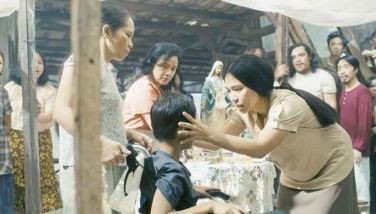A serious theme with a light treatment
Film review: Ang Huling Cha-cha ni Anita
MANILA, Philippines - Ang Huling Cha-cha ni Anita, written and directed by Sigrid Andrea Bernardo, is too good a film to miss. It reminds one of Ang Pagdadalaga ni Maximo Oliveros, written by Michiko Yamamoto and directed by Aureaus Solito, except that instead of a teenaged gay for the lead character, Ang Huling Cha-cha ni Anita is about the blossoming of a lesbian child.
This is a first in local cinema for it focuses on lesbianism. Male homosexuality abounds in mainstream and independent filmmaking such as Ang Tatay Kong Nanay, Moral, Pusong Mamon, Ang Pagdadalaga ni Maximo Oliveros and In My Life. In Bernardo’s film, the lesbian Anita is not bullied or laughed at neither by her neighbors nor by her mother. Lesbian sexuality is tackled seriously but in a tender, sensitive and light way.
Set not in the murky city, the story of Bernardo’s above-mentioned first full-length feature film takes place in a provincial town. You can almost smell the clean air, feel the innocence of children as well as the conservatism of ordinary townsfolk. Against this backdrop is the coming of age of Anita (Teri Malvar) and her friends Carmen (Len-Len Frial) and Goying (Solomon de Guzman). The serious theme has a light treatment.
The film does not bristle with verbal or physical violence, as is usual in movies about the marginalized or the outcast like people who are not straight. Instead, it is a quiet but gripping narrative about Anita, whose first love is Pilar (Angel Aquino). Anita’s mother Lolita (Lui Manansala), without being pushy, tries to turn her daughter into a “normal†girl by dressing her up in a gown for the town fiesta’s sagala. The obedient Anita grudgingly joins the procession, but slips out and finds herself breathlessly face to face with Pilar. Soon, Anita and Pilar become friends, and Anita begins to woo Pilar. Pilar gently and patiently rejects Anita. Pilar and her ex-boyfriend Oscar (Marcus Madrigal), now married, rekindle their relationship until Pilar becomes pregnant. Why she left Oscar in the first place and why she makes her choice in the end shows how a woman can make her own informed decisions by weighing cause and consequence.
Music (Diwa de Leon) and dance play a big part in Ang Huling Cha-cha ni Anita. Anita plays the harmonica, and the scene where Pilar teaches Anita how to play the harmonica is so seductive. Music allays Anita’s emotional pain and loneliness. Dance makes people forget their problems and transports them into the realm of self-expression and happiness. In contrast to the concept of abortion, Filipinos who wish to have children dance in Obando, Bulacan, during the feast of Sta. Clara. These and other layers of meanings unfold without pretension and without digression.
The superb cinematography of Alma dela Peña does not divert attention away from the narrative. The director handles all aspects with control, including acting. The actors are natural and never camera-conscious. The message is shown, not dogmatically wrapped in sermon or sloganeering.
Ang Huling Cha-cha ni Anita, produced by CineFilipino, Pixeleyes Multimedia and Ekweytormc, is now showing until Sept. 24 at Resorts World, Gateway Cinemas, Edsa Shangri-La and Lucky Chinatown.
Sigrid Bernardo, incidentally, won Best Director for her short film, Babae at the first Cinemalaya filmfest in 2005. She’s definitely among the young blood today that keeps Philippine cinema alive.
- Latest
- Trending





























 Exclusive
Exclusive

